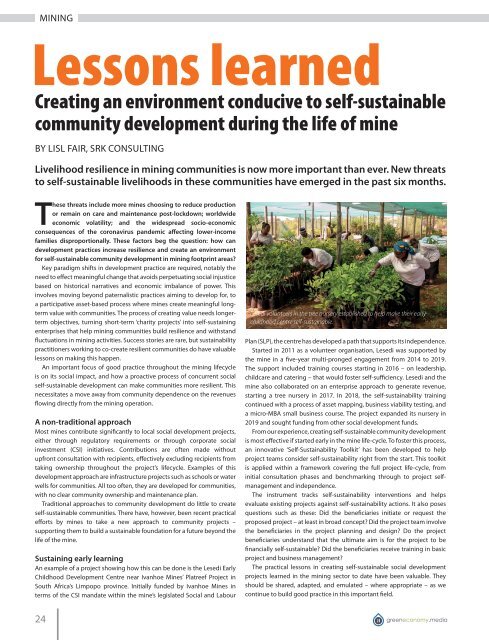Green Economy Journal Issue 41
You also want an ePaper? Increase the reach of your titles
YUMPU automatically turns print PDFs into web optimized ePapers that Google loves.
MINING<br />
Lessons learned<br />
Creating an environment conducive to self-sustainable<br />
community development during the life of mine<br />
BY LISL FAIR, SRK CONSULTING<br />
Livelihood resilience in mining communities is now more important than ever. New threats<br />
to self-sustainable livelihoods in these communities have emerged in the past six months.<br />
These threats include more mines choosing to reduce production<br />
or remain on care and maintenance post-lockdown; worldwide<br />
economic volatility; and the widespread socio-economic<br />
consequences of the coronavirus pandemic affecting lower-income<br />
families disproportionally. These factors beg the question: how can<br />
development practices increase resilience and create an environment<br />
for self-sustainable community development in mining footprint areas?<br />
Key paradigm shifts in development practice are required, notably the<br />
need to effect meaningful change that avoids perpetuating social injustice<br />
based on historical narratives and economic imbalance of power. This<br />
involves moving beyond paternalistic practices aiming to develop for, to<br />
a participative asset-based process where mines create meaningful longterm<br />
value with communities. The process of creating value needs longerterm<br />
objectives, turning short-term ‘charity projects’ into self-sustaining<br />
enterprises that help mining communities build resilience and withstand<br />
fluctuations in mining activities. Success stories are rare, but sustainability<br />
practitioners working to co-create resilient communities do have valuable<br />
lessons on making this happen.<br />
An important focus of good practice throughout the mining lifecycle<br />
is on its social impact, and how a proactive process of concurrent social<br />
self-sustainable development can make communities more resilient. This<br />
necessitates a move away from community dependence on the revenues<br />
flowing directly from the mining operation.<br />
A non-traditional approach<br />
Most mines contribute significantly to local social development projects,<br />
either through regulatory requirements or through corporate social<br />
investment (CSI) initiatives. Contributions are often made without<br />
upfront consultation with recipients, effectively excluding recipients from<br />
taking ownership throughout the project’s lifecycle. Examples of this<br />
development approach are infrastructure projects such as schools or water<br />
wells for communities. All too often, they are developed for communities,<br />
with no clear community ownership and maintenance plan.<br />
Traditional approaches to community development do little to create<br />
self-sustainable communities. There have, however, been recent practical<br />
efforts by mines to take a new approach to community projects –<br />
supporting them to build a sustainable foundation for a future beyond the<br />
life of the mine.<br />
Sustaining early learning<br />
An example of a project showing how this can be done is the Lesedi Early<br />
Childhood Development Centre near Ivanhoe Mines’ Platreef Project in<br />
South Africa’s Limpopo province. Initially funded by Ivanhoe Mines in<br />
terms of the CSI mandate within the mine’s legislated Social and Labour<br />
Lesedi volunteers in the tree nursery established to help make their early<br />
childhood centre self-sustainable.<br />
Plan (SLP), the centre has developed a path that supports its independence.<br />
Started in 2011 as a volunteer organisation, Lesedi was supported by<br />
the mine in a five-year multi-pronged engagement from 2014 to 2019.<br />
The support included training courses starting in 2016 – on leadership,<br />
childcare and catering – that would foster self-sufficiency. Lesedi and the<br />
mine also collaborated on an enterprise approach to generate revenue,<br />
starting a tree nursery in 2017. In 2018, the self-sustainability training<br />
continued with a process of asset mapping, business viability testing, and<br />
a micro-MBA small business course. The project expanded its nursery in<br />
2019 and sought funding from other social development funds.<br />
From our experience, creating self-sustainable community development<br />
is most effective if started early in the mine life-cycle. To foster this process,<br />
an innovative ‘Self-Sustainability Toolkit’ has been developed to help<br />
project teams consider self-sustainability right from the start. This toolkit<br />
is applied within a framework covering the full project life-cycle, from<br />
initial consultation phases and benchmarking through to project selfmanagement<br />
and independence.<br />
The instrument tracks self-sustainability interventions and helps<br />
evaluate existing projects against self-sustainability actions. It also poses<br />
questions such as these: Did the beneficiaries initiate or request the<br />
proposed project – at least in broad concept? Did the project team involve<br />
the beneficiaries in the project planning and design? Do the project<br />
beneficiaries understand that the ultimate aim is for the project to be<br />
financially self-sustainable? Did the beneficiaries receive training in basic<br />
project and business management?<br />
The practical lessons in creating self-sustainable social development<br />
projects learned in the mining sector to date have been valuable. They<br />
should be shared, adapted, and emulated – where appropriate – as we<br />
continue to build good practice in this important field.<br />
24 greeneconomy.media


















